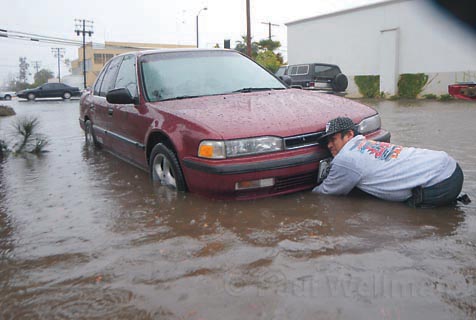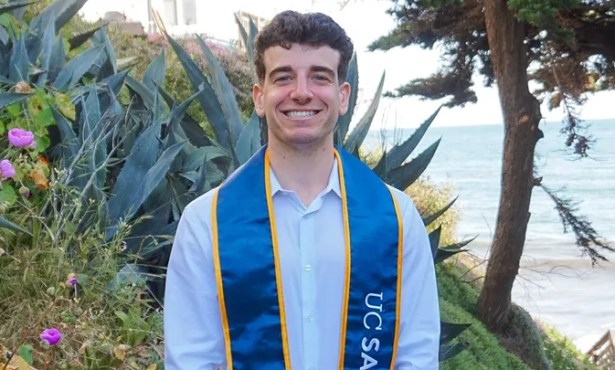Wet and Wild Weather Returns to the South Coast
Drought Buster

Not so long ago, Santa Barbara City Council members and county supervisors alike were looking at how best to combat the rain-starved realities of the past two years on the South Coast. Now, after eight straight days of rain, wind, hail, and even a few inches of snow in the foothills, drought is the furthest thing from their minds as creeks the county over are rushing wild and reservoirs like Jameson and Gibraltar are filled well past capacity. On Tuesday morning, in a testament to the massive soaking Santa Barbara received this past week, Cachuma Lake’s Bradbury Dam was opened for the first time since April 2006, sending some 20,000 cubic feet of water a second exploding into the Santa Ynez River for the next several days. Addressing reporters on hand to witness the release, Santa Barbara County Water Agency manager Rob Almy stated the obvious with a smile on his face, “So far this has been a very good year for water.”
The first of a series of low pressure systems crept into the area from the North Pacific mid-morning on January 21, bringing intermittent rain showers, heavy at times, throughout the day. As night fell, the rain picked up in intensity, though dry spells were still common; a nearly full moon was visible from downtown S.B. for much of the night. Tuesday brought more of the same, as sometimes torrential rain squalls and partly sunny skies battled it out, casting fleeting yet frequent rainbows over both Santa Barbara Channel waters and the canyons of the front county. A more powerful storm front rolled in on Wednesday, breaking 24-hour rainfall records at both the Santa Maria and Santa Barbara airports. (The latter saw some 4.16 inches fall during the day, shattering a 1943 record.) A few inches of wet snow blanketed places like La Cumbre Peak and East Camino Cielo Road and provided fuel for more than few snowball fights and the appearance of the occasional beachfront snowman in downtown S.B.
County Fire crews rescued motorists trapped in a raging creek crossing near Hollister Ranch on January 23, as traffic snarled throughout the day and night in both the north and southbound lanes of Highway 101 from rain-caused fender-benders. The National Weather Service even issued a rare tornado watch for the Refugio area of Gaviota in the early morning hours of January 24. Later that same night, weather-induced power outages threatened the opening night ceremonies of the Santa Barbara International Film Festival and left buildings around the 1300 block of State Street without electricity for several hours.
After a brief respite from the foul weather, perhaps the biggest storm of the deluge came in on Saturday, January 26, and rained continually through to Monday. With strong south winds, sometimes in excess of 40 miles per hour, the back end of the wild week was responsible, said Santa Barbara Harbor Patrol officials, for washing a half dozen boats onto East Beach and sinking yet another in the stormy Channel waters. Even more impressively, the rain caused a substantial sinkhole to form along the coastal side of Shoreline Park, threatening to take out a portion of the bluff top and force a sidewalk re-route. All told, data collectors at the Santa Barbara County Flood District put total rainfall from the wild week at more than seven inches for downtown S.B., nearly 12 inches for Lake Cachuma, and more than 13 inches at Gibraltar Dam. Compared to the rainfall for a “normal” water year, to date rain statistics for the 2007-8 season already are more than 200 percent past the norm.
On a related and perhaps ultimately more serious note, Gibraltar Reservoir, which provides water to the City of Santa Barbara and is of particular import to users during the bone-dry days of late summer, has taken on a disturbingly “tea-like” appearance in recent days due in large part to run-off containing silt and debris from the Zaca Fire, said Santa Barbara City water resources manager Rebecca Bjork. As a result, though the reservoir was actually at capacity before the most recent run of rain had a chance to nourish it, it now contains enough silt to cover 7,000 acres a foot deep, significantly stunting the reservoir’s overall capacity. “What we are looking at right now is water that is pretty poor,” Bjork explained. And while the challenges of sediment infiltrating Gibraltar are nothing new, the impacts of the Zaca Fire-which are now, thanks to the rain, really beginning to manifest themselves-could force a change in where Santa Barbara gets its water, if and when drought-like conditions return. “I think [Zaca plus the rain] has probably taken 10 years off the life of the reservoir,” Bjork speculated.



